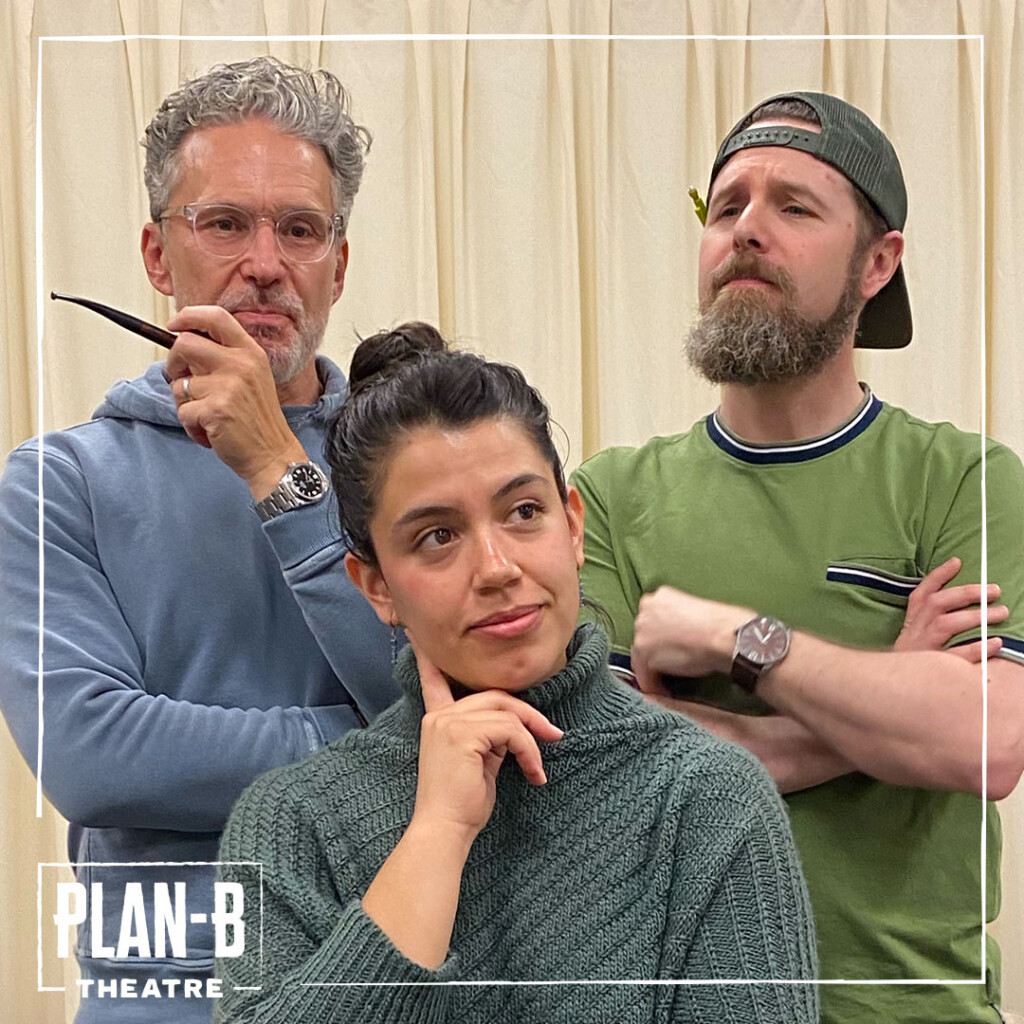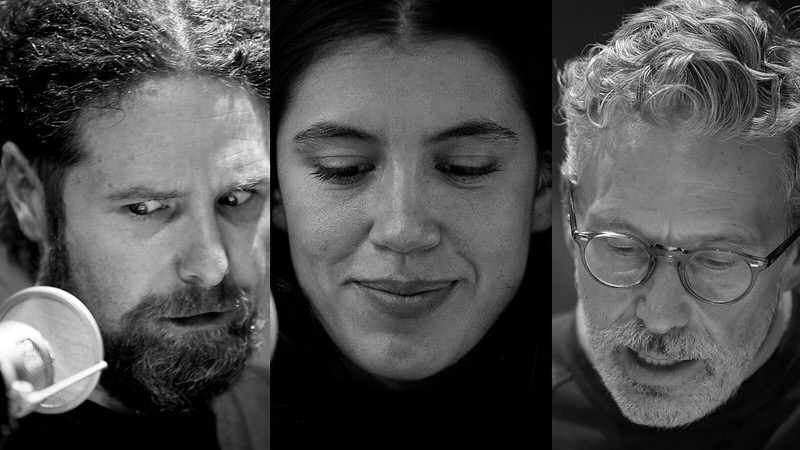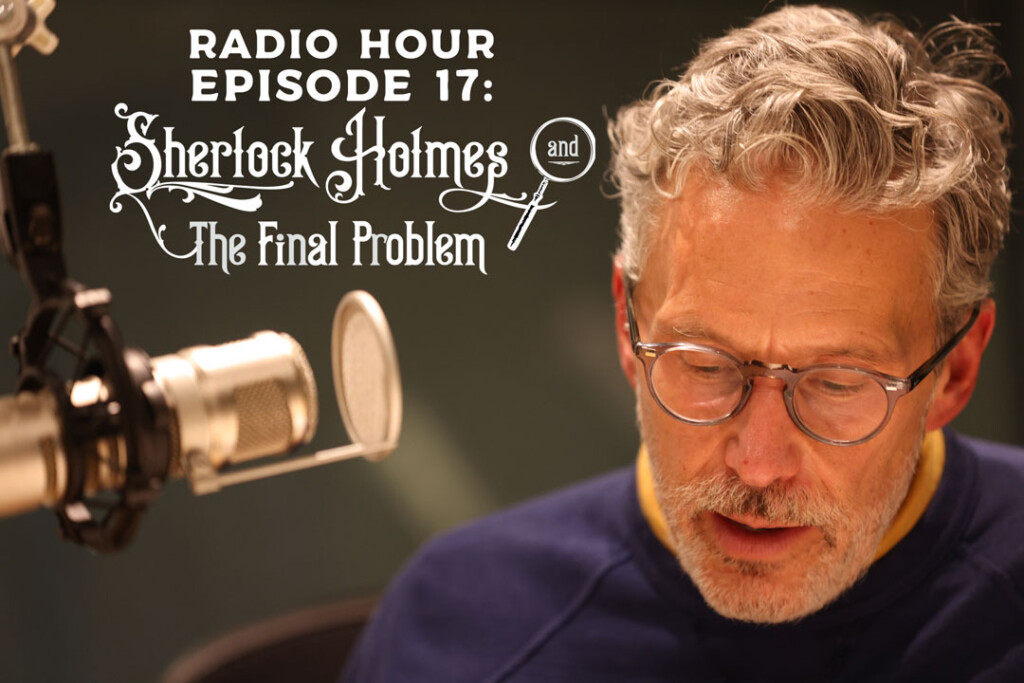EDITOR’S NOTE: On Friday, Oct. 27, at 11 a.m., from the Rose Wagner Performing Arts Center, The Utah Review will live blog the world premiere of Radio Hour Episode 17: Sherlock Holmes and The Final Problem, produced by Plan-B Theatre and KUER-FM’s RadioWest program. Tune into KUER-FM 90.1 and follow The Utah Review during the broadcast.
For the first time since 2014, a new episode of Plan-B Theatre’s Radio Hour series, produced with KUER-FM’s RadioWest show, will have a live audience for its premiere. And, the series returns to a famous Sherlock Holmes story for its 17th episode, which will have two live performances in the Jeanné Wagner Theatre of the Rose Wagner Center for Performing Arts on Oct. 27 at 11 a.m. and 7 p.m. Both performances will be broadcast on RadioWest, KUER-FM 90.1.
Writing his 13th episode for the Radio Hour series, Matthew Ivan Bennett decided to adapt Sir Arthur Conan Doyle’s The Final Problem short story, in which the famed fictional detective is killed. The 1893 story sent Sherlock Holmes fans into shock and mourning, with many following Victorian Era conventions by wearing black armbands and putting up black crepe paper. Doyle had hoped that by killing off Holmes, he could finally gain recognition for his other work. The pushback was so strong that eventually Doyle had to ‘resurrect’ Holmes. Nevertheless, the Holmes literary enterprise has been rock solid and 130 years later, it still inspires contemporary adaptations in fan fiction, theatrical productions, television and film.
Bennett, who has written both original and adapted radio plays, once again demonstrates his superb skills for producing a 48-minute script that is loyal to its original literary source. But, he also infuses his own contributions with the right subtlety to give it a fresh contemporary interpretation. In The Final Problem, Bennett gives us Dr. Watson, who always has been Holmes’ most trusted friend, as a woman. With this significant change, Bennett achieves what Doyle could not accomplish. Bennett teases out a deeper emotional context about a towering intellectual paragon of logic whom everyone saw as a great man. Indeed, The Final Problem opens the doors to envisioning Holmes as a decent man capable of admitting just how much he admired Watson, not just professionally but also in a personally intimate way.
As any reader of a Sherlock Holmes story can attest to, the detective was unsurpassed in his logical abilities to pay scrupulous attention to every last detail as a clue. One instance of this in Bennett’s adaptation comes early in the play. Holmes observes that an indentation on Watson’s middle finger on her right hand is less pronounced than usual, which he assumes means she has been taking fewer notes on her patients. Watson confirms this. Likewise, Holmes notes that Watson’s neighbor is so accommodating that she has given the doctor a plate of roast chicken. At first, Watson tries to disprove Holmes’ observation but then asks him how he knew about the chicken. Holmes tells her that he knew because of a grease stain on her blouse and that he could smell roasted chicken on her breath.
This is the second time that Plan-B has adapted a Holmes story for Radio Hour. In 2012, in a holiday season premiere with a live audience, the seventh Radio Hour episode was based on the 1892 short story, The Adventure of the Blue Carbuncle, the only in the Holmes series that was set in the Christmas season. Bennett hopes the most attentive and loyal Radio Hour fans will be able to spot two passing references to previous episodes in his latest script. One comes from the Blue Carbuncle and the other comes from the ninth Radio Hour episode that featured Bennett’s adaptation of three Grimm Brothers stories, which was the last time when Radio Hour premiered with a live audience.
The familiar canon Sherlock Holmes is ripe for effective contemporary adaptations. The only human foible in the Doyle stories that Holmes was seen as having was connected to his smoking and using cocaine and morphine, which was legal during the Victorian era. But, Doyle also left a gap big enough for any admissible interpretation about what Holmes might have been attracted to sexually or romantically, without it necessarily straining its possible believability.

Likewise, switching the genders with Holmes and Watson has become popular in fan fiction but also has been well received in recent theatrical releases. Kate Hamill’s Ms. Holmes & Ms. Watson—Apt. 2B turns the classic detective franchise into a gal pal comedy. Miss Holmes by Christopher M. Walsh is a thrilling murder mystery. Walsh’s play, which premiered seven years ago, was so successful that his followup, Miss Holmes Returns, is now hitting the stages. In that story, the detective aids a nurse and activist of Indian heritage who is on the run from authorities who suspect that she committed murder.
Bennett’s casting of Dr. Watson in The Final Problem as a woman in Victorian England is solidly plausible. To wit: Elizabeth Garrett Anderson who in 1865 became the first woman in Britain to be fully qualified to practice medicine as a physician and surgeon.
Bennett follows the narrative in The Final Problem, in which Doyle introduced Professor James Moriarty to readers. For Blue Carbuncle, Bennett said he had to flesh out quite a bit of dialogue, because the original story was only 3,500 words. This time, he said the process was a lot easier. He said that he had gone through six or seven Holmes stories before settling on The Final Problem. “It stands out for its writing and the different tone set because it is not a mystery but it becomes a send-off to the character,” he added. “But, I also realized that I needed a subplot with emotional force.”

A famous mathematician, Moriarty possesses all of the powers and intellect and logic attributed to Holmes. But the difference is that Moriarty is wholly evil. Holmes and Watson hope to stop Moriarty, and the story eventually lands in Meiringen, Switzerland. Holmes and Watson are hiking on a path near the Reichenbach Falls when a messenger from a nearby hotel catches up with them. He has been instructed to bring Dr. Watson because a hotel guest has suddenly fallen ill. In Doyle’s original, Holmes is now left alone and this becomes the final visual reference to the famed detective. Everything else is up for one’s imagination. Of course, the message to separate Watson from Holmes was a ruse concocted by Moriarty. Watson rushes back to the falls and finds a note which ties together all of the foreboding signs for the reader.
Bennett takes the opportunity to visualize how the final struggle between Holmes and Moriarty might have materialized at the Reichenbach Falls scene. Also, in the scene which takes place on that Swiss mountain top overlooking the falls, Bennett saw the opportunity for the two principal protagonists to pause and linger, leading to the emotional dialogue that Holmes and Watson have. The script reveals just how deftly Bennett can invoke the archetype of the genius while still humanizing the individual as capable of possessing the hesitations and doubts associated with the quotidian human experience.
The beautifully convenient irony is that while Doyle had placed Holmes squarely in the strict conventions of Victorian England, he also had left out enough details so that 21st century writers could bring out Holmes as an empathetic, conscientious human. Thus, Holmes is as capable of emotional love as he is as an individual of profound logic and reason. And, Bennett demonstrates how this can be accomplished without sacrificing the familiarity of the canon behind the character’s creation.

The newest Radio Hour production has all of the signature features that have made this creative brand so successful. This is the sixth episode to be presented in front of a live studio audience (while the remainder were performed in front of a studio audience at KUER-FM studios). Cheryl Ann Cluff returns as director. The cast includes Jay Perry (Moriarty and all minor character roles), who has appeared in every Radio Hour production); Isabella Reeder (Watson), who is making her fourth Radio Hour appearance, and Doug Fabrizio (Holmes), the host of RadioWest who is making his sixth appearance as an actor and the second as the famous detective.
Other production team members include musician and composer David Evanoff, Emilio Casillas (lighting designer). Daniel Charon (projections designer), Joe Killian (sound designer and eFoley), Brian Albers and Jay Clark (sound engineers) and Bridgette Lehman (stage manager).
Tickets are available for both performances. For more information, see the Plan-B Theatre website.


